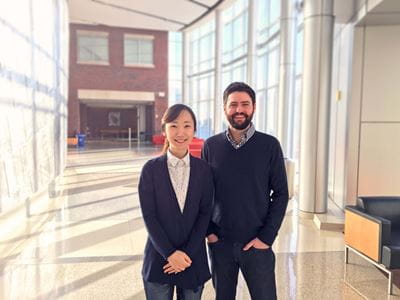In a new study published in the journal Cell Reports, biomedical researchers have demonstrated for the first time that hair follicles can be grown in cultures of stem cells from mice.
The research was led by Indiana University School of Medicine’s Karl Koehler, PhD, assistant professor of otolaryngology-head and neck surgery, and Jiyonn Lee, PhD, a postdoctoral fellow in his lab. Dr. Koehler said their findings could lead to new therapies for skin disorders and cancers, as well as new approaches to model disease in biomedical research.
Read on for a Q&A with Dr. Koehler, who explains the study’s results.
Q: What does it mean to grow an organ ‘in culture’? How does that work?
Dr. Koehler: Researchers today can use stem cells to make organ-like tissues in a culture dish. We call them “organoids” because they contain many of the same cells, arranged in the same structure, that we see in organs in the body. Our lab uses pluripotent stem cells, which is a blanket term for cells derived from embryos (embryonic stem cells) or induced from adult cells, such as a blood cell (induced pluripotent stem cells). These cells have the ability to produce any cell in the body, but they need our guidance. We try to mimic the chemical or mechanical signals the cells receive during development in order to steer them toward becoming a particular organ.
Q: Up until now, why has hairy skin been so difficult for scientists to recreate in culture?
A: The skin has two layers: the epidermis (top layer) and the dermis (bottom layer). Hair is formed at the interface of the two layers. The cells in the epidermis and the dermis arise from a different part of the embryo, which creates a problem for engineering skin in culture. Do you create each layer separately and then sandwich them together? Or, do you have to generate each layer at the same time?
Q: How did your research team solve these challenges?
A: Our study suggests that we can create the epidermis and dermis simultaneously. Then, the cells organize themselves in a way that allows hair to develop like it does in the body. We found the right culture environment to let the cells properly self-organize.
Q: What do you think is most exciting or surprising about this discovery?
A: The first time we saw hair follicles—about six years ago now—it was quite a shock. After about 20 days in culture, the skin organoids sprout follicles. The roots of the follicles protrude from the skin organoids in all directions. In addition to the major epidermal and dermal cell types we also found specialized cell types, such as melanocytes (pigment cells), Merkel cells (touch sensing cells), adipocytes (fat cells), sebaceous gland cells, and hair follicle stem cells in organoids. This is fascinating because it shows that if we derive the basic building blocks of skin together in culture, then these diverse cell types will self-assemble on their own.
Q: Your findings were accomplished using pluripotent stem cells from mice. What immediate and future implications does this work have for humans?
A: We are currently using the mouse organoids as a template to derive hairy skin from human pluripotent stem cells. This work has the potential to lead to new skin reconstruction techniques—incorporating hair follicles—and therapies for human diseases, including alopecia, acne, and skin cancers.
Q: What about implications for research in general?
A: As biomedical scientists, we rely on animals for research. If a drug does not work on an animal it is less likely to work on a human being. However, drugs that work on animals don’t always work on humans. If we can generate skin organoids from human stem cells, we may have a good replacement for some of the animal models that are used today for testing skin-related drugs. At the very least, we may be able to lower the number animals used for research. Animal welfare is an important issue and maintaining large numbers of animals is very costly, so we are always looking for alternatives.
There is a long list of other organs that arise at the interface of epidermal- and dermal-like cells, such as the lining of the mouth, tongue, salivary glands, lining of the sinuses, cornea, lacrimal glands (tear ducts), and mammary glands. Our work may provide insight into how these tissues could be mimicked in cell culture.
Q: What’s the next step for your research? Any other challenges you foresee?
A: I would caution that there are several technical hurdles that we have yet to overcome for the skin organoid model to reach its full potential as a drug discovery tool. For instance, the skin organoids are missing immune cells, blood vessels, and nerve endings found in normal skin.
The shape of skin organoids is another problem that needs to be addressed in the future. Because the organoids are inside-out compared to normal skin, the layers of dead cells and hairs cannot be shed as they are normally, so we need to find a way to flip the structure of skin organoids. Without these changes, the skin organoids have a shelf life of about a month, which is just long enough to study the complete development of mouse skin and hair.
Top Image: Jiyoon Lee, PhD, and Karl Koehler, PhD.
